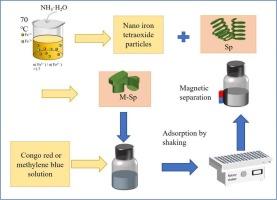水基磁流体-螺旋藻对染料的高效吸附:合成与应用
IF 4.5
2区 生物学
Q1 BIOTECHNOLOGY & APPLIED MICROBIOLOGY
Algal Research-Biomass Biofuels and Bioproducts
Pub Date : 2025-09-22
DOI:10.1016/j.algal.2025.104311
引用次数: 0
摘要
处理不同类型染料废水的持续挑战推动了创新生物吸附技术的发展。与传统的生物吸附剂不同,新型磁功能化材料能够在外加磁场下实现固液快速分离,克服了实际应用中的关键瓶颈。本研究提出了一种突破性的方法,即通过将Fe3O4纳米颗粒与螺旋藻(Spirulina platensis, Sp)微藻进行纳米级集成,来设计一种磁响应的杂交生物吸附剂。合成的磁性螺旋藻(M-Sp)表现出前所未有的双亲和性,既能去除阴离子(刚果红)染料,又能去除阳离子(亚甲基蓝)染料。结果表明,在磁流体4 mL /藻类2.0 g、吸附剂用量0.8 g/L、CR(阴离子)pH 3、MB(阳离子)pH 9的条件下,M-Sp的去除率最高。通过先进的表征和机理研究,揭示了独特的结合机制:CR遵循Freundlich多层吸附,而MB表现出Langmuir单层行为,通过与杂化基质上官能团的特定相互作用介导。吸附量可达101.78 mg/g (CR)和218.57 mg/g (MB)。这项工作不仅为不同类型的染料污染物提供了可回收的解决方案,而且通过控制纳米材料与生物的结合,为设计智能生物吸附剂开辟了新的途径。本文章由计算机程序翻译,如有差异,请以英文原文为准。

Efficient dye adsorption by water-based magnetic fluid-Spirulina platensis hybrid: synthesis and application
The persistent challenge of treating different kinds of dye wastewaters has driven the development of innovative biosorption technologies. Unlike conventional bio-adsorbents, the novel magnetic functionalization enabled rapid solid-liquid separation under external magnetic fields, overcoming a critical bottleneck in practical applications. This study presented a breakthrough approach by engineering a magnetically responsive hybrid biosorbent through the nanoscale integration of Fe3O4 nanoparticles with Spirulina platensis (Sp) microalgae. The synthesized magnetic Spirulina platensis (M-Sp) demonstrated unprecedented dual-affinity, achieving removal of both anionic (congo red; CR) and cationic (methylene blue; MB) dyes. Results showed that M-Sp achieved the highest removal efficiency under the conditions: 4 mL magnetic fluid/2.0 g algae, 0.8 g/L adsorbent dosage, pH 3 for CR (anionic), and pH 9 for MB (cationic). Through advanced characterization and mechanistic studies, the unique binding mechanisms were revealed: CR followed Freundlich multilayer adsorption while MB exhibited Langmuir monolayer behavior, mediated by specific interactions with functional groups on the hybrid matrix. The adsorption capacities could reach 101.78 mg/g (CR) and 218.57 mg/g (MB). This work not only provided a recyclable solution for different kinds of dye pollutants but also opened new avenues for designing smart biosorbents through controlled nanomaterial-biology integration.
求助全文
通过发布文献求助,成功后即可免费获取论文全文。
去求助
来源期刊

Algal Research-Biomass Biofuels and Bioproducts
BIOTECHNOLOGY & APPLIED MICROBIOLOGY-
CiteScore
9.40
自引率
7.80%
发文量
332
期刊介绍:
Algal Research is an international phycology journal covering all areas of emerging technologies in algae biology, biomass production, cultivation, harvesting, extraction, bioproducts, biorefinery, engineering, and econometrics. Algae is defined to include cyanobacteria, microalgae, and protists and symbionts of interest in biotechnology. The journal publishes original research and reviews for the following scope: algal biology, including but not exclusive to: phylogeny, biodiversity, molecular traits, metabolic regulation, and genetic engineering, algal cultivation, e.g. phototrophic systems, heterotrophic systems, and mixotrophic systems, algal harvesting and extraction systems, biotechnology to convert algal biomass and components into biofuels and bioproducts, e.g., nutraceuticals, pharmaceuticals, animal feed, plastics, etc. algal products and their economic assessment
 求助内容:
求助内容: 应助结果提醒方式:
应助结果提醒方式:


